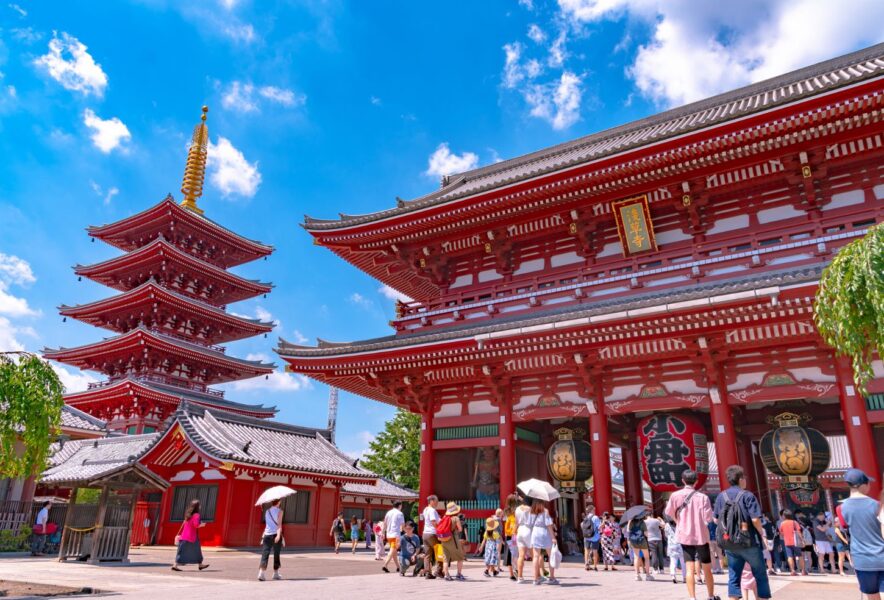Tokyo’s Traditional Architecture: Sites Steeped in History
Walking through Tokyo, you’ll encounter buildings that transcend time. Personally, I was captivated by the grandeur of Senso-ji Temple the first time I visited. Founded in 628, this temple welcomes visitors with its iconic structures like the Thunder Gate and the five-story pagoda, allowing you to truly feel the depth of Tokyo’s history. When I looked up at the giant lantern of the Thunder Gate, I could sense the strong energy rooted in Japan’s traditional culture.
Another special place for me is Meiji Shrine, where you can escape the hustle and bustle of the city and find a moment of tranquility. Established in 1920 to honor Emperor Meiji, this shrine stands amidst lush greenery, creating a serene world of its own. Walking through the torii gate and along the shrine’s pathway, I find myself leaving behind the busyness of everyday life, feeling a sense of purification.
Experiencing Tokyo’s Modern Architecture
On the other hand, Tokyo is also a treasure trove of modern architecture that offers a glimpse into the future. I was particularly struck by the sheer scale and height of the Tokyo Skytree when I first visited. Opened in 2012, this tower stands 634 meters tall, offering breathtaking panoramic views of Tokyo from its observation deck. Visiting at night, the illuminated Skytree shines as a symbol of the city, making you feel as if you’ve stepped into a futuristic metropolis.
Another favorite spot of mine is Roppongi Hills, a complex that seamlessly integrates commercial facilities, offices, and residences with a sleek and urban atmosphere. The view from the Tokyo City View observation deck is particularly inspiring, showcasing the vibrancy of Tokyo’s culture and the dynamic energy of the city.
A City Where the Old and New Coexist
One of Tokyo’s charms is the way traditional and modern elements coexist harmoniously. For example, while strolling around the Imperial Palace one day, I was struck by the simultaneous presence of ancient castle ruins and modern skyscrapers. This blend of eras is unique to Tokyo, creating a natural fusion of past and future that left a lasting impression on me.
Walking through Omotesando, you’ll see traditional machiya-style buildings standing side by side with the latest fashion buildings. Omotesando Hills, designed by Shigeru Ban, is particularly striking with its unique fusion of tradition and modernity. Shopping here feels like a luxurious experience, where you can enjoy the architecture itself as much as the retail offerings.
Surprising Architectural Contrasts in Tokyo
Exploring Tokyo’s architecture, many visitors are surprised by the distinctive contrasts. Traditional Japanese architecture is predominantly wooden, emphasizing harmony with nature. For example, the wooden structures at Senso-ji Temple exude warmth and tranquility. In contrast, many buildings in other countries are primarily made of stone or reinforced concrete, focusing on functionality and durability. This difference adds a unique charm to Tokyo’s cityscape.
Moreover, Tokyo’s urban planning includes various innovations to efficiently utilize limited space. Despite the dense clusters of skyscrapers, the city is dotted with green parks, offering spaces where you can still connect with nature amidst the concrete jungle. These architectural contrasts are key to understanding Japan’s approach to building design and values.
Recommended Route for Exploring Tokyo’s Architecture
If you’re planning to explore Tokyo’s architecture, I recommend starting at Senso-ji Temple. After immersing yourself in the history and atmosphere of old Tokyo, cross the Sumida River to visit the Tokyo Skytree, where you can take in the breathtaking views of the entire city.
Next, stroll around the Imperial Palace area, where you can enjoy the contrast between historical structures and modern buildings. Finally, visit Omotesando Hills and Roppongi Hills to experience the cutting-edge architectural culture of Tokyo. The view from the Tokyo City View observation deck is particularly recommended, offering a panoramic view of Tokyo’s dynamic cityscape.
Conclusion
Tokyo is a city where traditional and modern architecture harmoniously coexist. Visiting historical temples and shrines allows you to deeply understand Japan’s traditions, while exploring modern architecture offers a sense of awe at the forward-thinking designs. For visitors, these experiences are bound to be both fresh and full of surprises. On your next trip to Tokyo, be sure to include an architectural tour in your itinerary to fully enjoy the multifaceted beauty of the city.

Comment